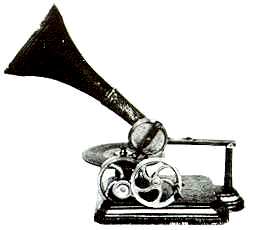
Kämmer & Reinhard Berliner 'Toy' machine produced by Kämmer & Reinhard in Waltershausen, Germany. Metal base, paper mache horn.
More info to follow......
More pictures &
data about this type of machine are at ROMFI
(item# 10958)
Music Reproduction > Phonograph-Disk > Berliner
Gramophone Co.> 1889
(You
can add to the data or pictures by pressing the "REVIEW OBJECT"
button at the top of that page)
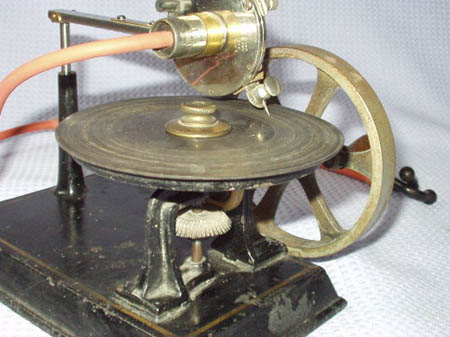
Kämmer & Reinhard Berliner Rectangular Metal base
A slightly longer base than the first Kämmer & Reinhard Berliner 'Toy'. The winding handle seems to act directly on a gear that turns the turntable.
(there is a similar model with an even longer bedplate and identical flywheel positioned further down the bedplate, that drives that turntable via a leather strap - hopefully soon a picture of this as well.)
More pictures &
data about this type of machine are at ROMFI
(item# 10124)
Music Reproduction > Phonograph-Disk > Berliner
Gramophone Co.> 1890
(You can add
to the data or pictures by pressing the "REVIEW OBJECT" button
at the top of that page)
Kämmer & Reinhard Berliner Wood base - 5" records
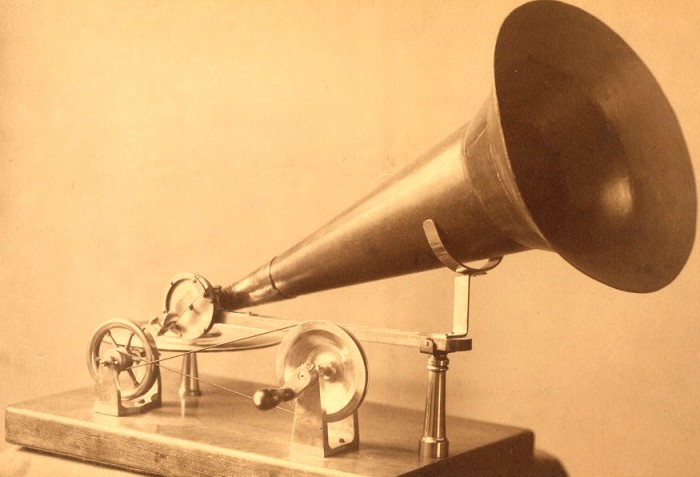
Berliner Hand Driven gramophone (USA, UK & Europe)
The first really 'Commercially' produced Gramophone. Played 7 inch records
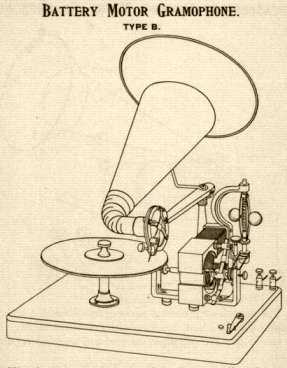
Berliner Type B - Battery Motor Gramophone
Ultra rare - if not non-existant
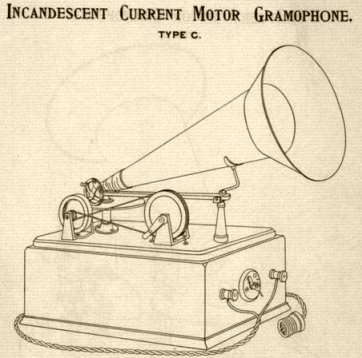
Berliner Type C - Incandescent Current Motor Gramophone
Ultra rare - if not non-existant
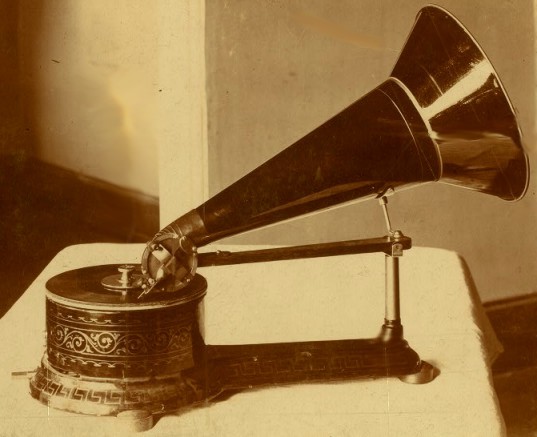
Berliner Clockwork Motor
?
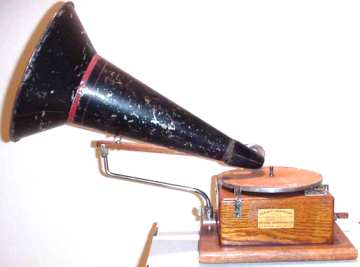
Montross Berliner - Clockwork Motor designed by Levi Montross
In early 1896, Berliner contracted with Eldridge Johnson to develop an improved spring motor for a gramophone. Johnson turned to machinist Levi Montross to help him manufacture a spring-motor gramophone for the Berliner company, and they filled the first order of 200 machines that Berliner requested by Aug. 10 at $4 each wholesale. Montross received patent 598,529 for his design.
(Eldridge Johnson in the next year designed a simple and inexpensive motor that became the standard for the next few years [patent 601,198]).
Not more than 600 Montross Berliners were manufactured
More pictures of this
type of machine at ROMFI
(item# 10189)
Music Reproduction > Phonograph-Disk > Berliner
Gramophone Co.> 1896
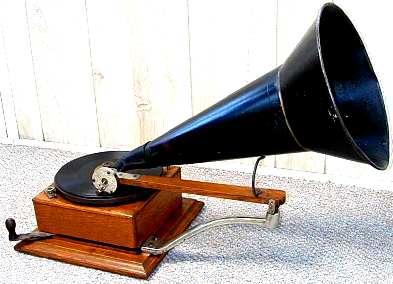
Berliner Lever Wind
The machine was wound by pulling a ratcheted lever from side to side (Similar to some Polyphon & Symphonion Music Boxes) rather than with a rotating crank as is typical of all other old phonographs. This lever-wound mechanism is unique in the history of antique phonographs and was extremely short-lived. The cabinet has a slot across the entire side to allow adequate room for the winding lever.
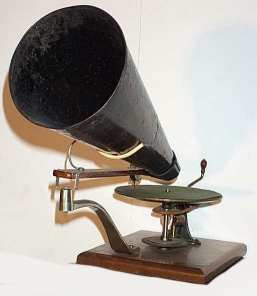
Berliner Style 2 - Handwound (Similar in most countries)
Like all hand wound machines, a nuisance to operate. After putting the record (7 inch size) on the 7 inch turntable, & placing the needle at the first groove, you begin to turn the handle that drives the turntable. First problem is that you have to kind of guess the correct record speed, and secondly, the machine is fairly lightweight so you have to hold it down!
Two minutes does last a long time, with the risk sprained muscles in your forearm!
It is however a very historically relevant machine aimed at a cheaply priced 'everyman' gramophone.
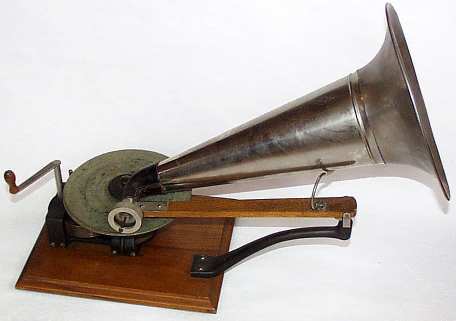
Berliner Style 3 - Open Motor Berliner (Similar in many countries, not sold in USA)
This style Berliner had a very short lifespan as the open work machine was extremely impractical, as if it was over lubricated, it sprayed oil in all directions, the motor noise was not dampened, it attracted dirt into the motor. As a 'cheap' machine much of the castings were not nickled.
Though undoubtedly interesting to see how the motor functions, it was not very practical. (The Zonophone Model A solved the problem elegantly by having 2 bevelled glass windows on the motor case.)
More pictures &
data about this type of machine are at ROMFI
(item# 10959)
Music Reproduction > Phonograph-Disk > Berliner
Gramophone Co.> 1897
(You
can add to the data or pictures by pressing the "REVIEW OBJECT"
button at the top of that page)
Berliner Style 4 - Metal Housing "Jelly Mould" (Similar in many countries)
This model had a metal casing covering the motor, probably as a response to the 'Model 3' (coming Soon) that was a motorized berliner, but with an open motor. The main drawback of the open motor Model 3 was that it tended to spray oil in all directions.
This style machine
was still in the French Catalog in 1903.
More pictures of this
type of machine at ROMFI
(item# 10286)
Music Reproduction > Phonograph-Disk > Berliner
Gramophone Co.> 1897
(You
can add to the data or pictures by pressing the "REVIEW OBJECT"
button at the top of that page)
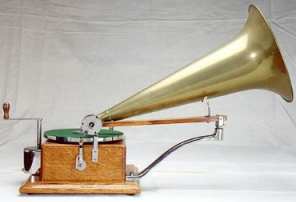
Berliner Style 5 - Trademark
The Berliner that became part of the worlds most recognisable logo, and most recognisable gramophone. The way this famous painting came about is that the artist Francis Barraud had initially painted a dog listening to an 'Edison Bell' phonograph woth a dark horn. The Edison Bell people were not interested in the painting. He thought that the painting would be more appealing with a brass horn, and approached the Berliner office in London for the loan of a horn.
The office Manager, Barry Owen offered to buy the painting if Barraud would paint out the 'Edison-Bell' machine and replace it with a Berliner Style 5. In October 1899 Mr Barraud received £50 for the painting and £50 for the Copyright. In 1900 Emile Berliner in the USA requested permission from the London office to use the picture in the USA as well - which of course was granted.
The painting made Mr. Barraud famous, and he painted and sold many replicas of his original.
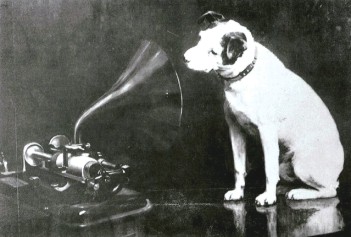
The Original Painting

As we know it today
(In the 1970's Leonard Petts in the UK thought that Barraud may have made a photograph of his original work & went in search of it. Mr Petts also researched the history of 'Nipper' the dog. His booklet "The Story of Nipper & His Masters Voice" is well worth a read)

Trademark - Late Model (Similar in most countries)
Side brake replaced with latch brake at the right back corner of the machine
More pictures of this
type of machine at ROMFI
(item# 7460)
Music Reproduction > Phonograph-Disk > GRAMOPHONE
Co. HMV UK > 1899
(You
can add to the data or pictures by pressing the "REVIEW OBJECT"
button at the top of that page)

Trademark - Late Model Mahogany (France)
Only in France during the 'Belle Epoque,' however, did this classic phonograph take on an aura of true elegance, cased in dark red mahogany and accented by a brightly nickeled horn -- infinitely richer in appearance than its more humble cousins. (Everywhere else the case was made of light oak, and the horn was either black or brass). Interestingly, the motor and reproducer were made in the United States, while the cabinet was made in England. The machine itself, however, was only marketed in France.

Berliner Coin Operated Top Wind (Europe)
This was the first coin-operated type disk phonograph.As opposed to Cylinder coin-operated machined that were fairly automated, disk gramophones were not, particularly since the steel needle had to be changed after each record. (Cylinder machines used a permanent sapphire stylus.)
A customer wishing to listen to a disk record had to select a record (7" disk) from a stack held in the opening at the right front of the machine. (This was an advantage over cylinder coin-ops, which only held one selection). The record then was put on the turntable and secured with the hold-down clamp. The needle would then be replaced, using a fresh needle taken from the cup next to the coin slot at the end of the cabinet. A penny would be dropped in the slot, freeing the crank so the spring could be wound up. Pushing a plunger would start the turntable rotating, and the customer would finally position the needle in the opening groove so the record could play. A mechanical timing mechanism let the motor run just long enough for one record, so the customer could not replay even a portion of the same song without paying another penny. A ratchet prevented winding the spring by rotating the turntable backwards. It was an ingenious mechanism but burdensome for the patron, and as a result it was not very successful.
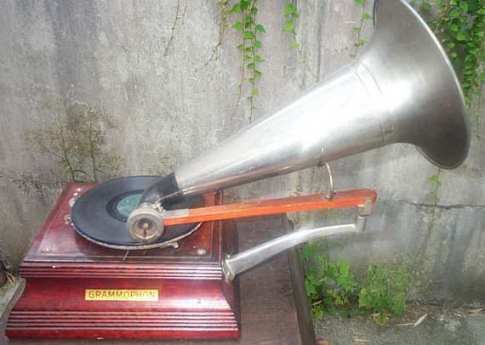
De-Luxe Model (Germany)
Fancy Mahogany case. Support arm is specific to this machine.
More pictures of this
type of machine at ROMFI
(item# 7461)
Music Reproduction > Phonograph-Disk > GRAMOPHONE
Co. Germany >
(You
can add to the data or pictures by pressing the "REVIEW OBJECT"
button at the top of that page)
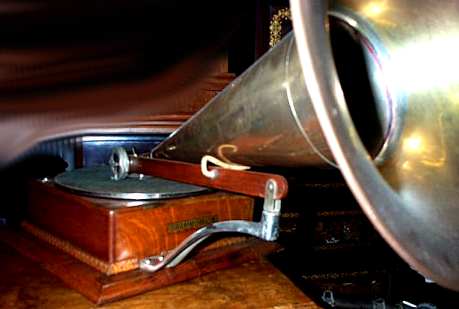
Berliner Junior Monarch Top Wind (Europe)
Contained the same Berliner style motor as a trademark, except that the motor was turned 45 degrees to the right, with the hole for the winder protruding from the upper right corner of the case. The case was larger than that of a trademark and covered the motor entirely. The turntable was 10 inches in diameter.
This model grew into the Junior Monarch - as it was known in Europe.
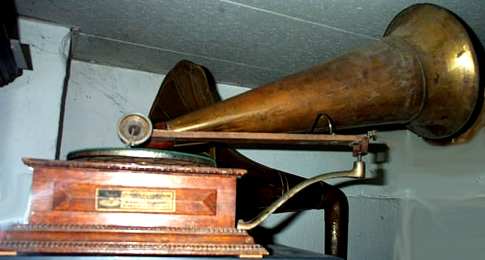
Berliner Style 4a Top Wind (Europe)
A much more fancy cased version of the Junior Monarch. Contained the same Berliner style motor as a trademark, except that the motor was turned 45 degrees to the right, with the hole for the winder protruding from the upper right corner of the case. The case was larger than that of a trademark and covered the motor entirely. The turntable was 10 inches in diameter.
It could be that this model, with its carved and shaped cabinet was the first in the line of fancy cabinets and thus the not so distant ancestor of the Senior Monarch
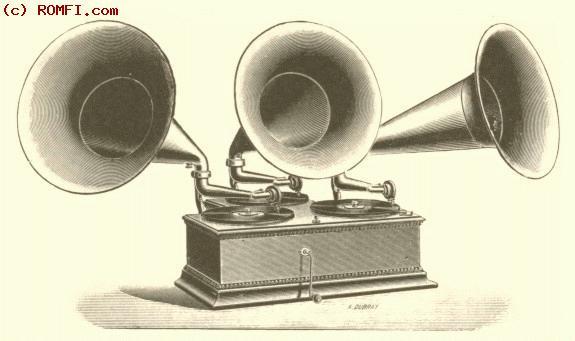
Triplophone Gramophone (Gramophone Compagnie Francaise)
Not quite Quadrophonic! It's unclear if this machine was actually built, or just an artists conception. Must have been quite difficult to synchronise the 3 records. The cabinet has the same design elements as a contemporaty 'Junior Monarch'